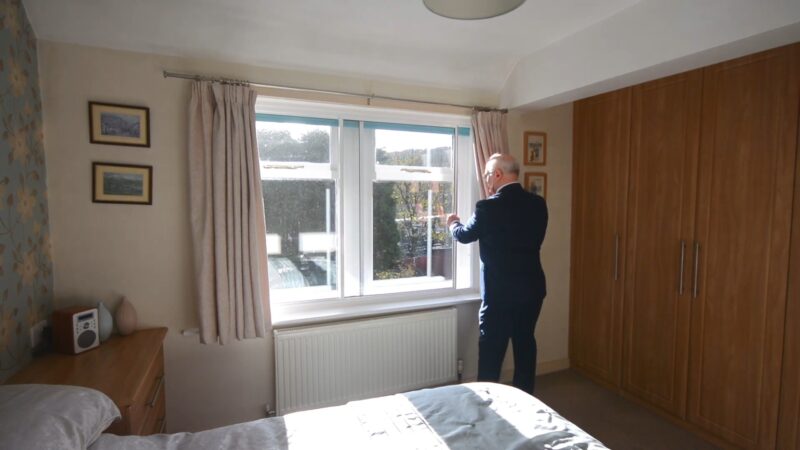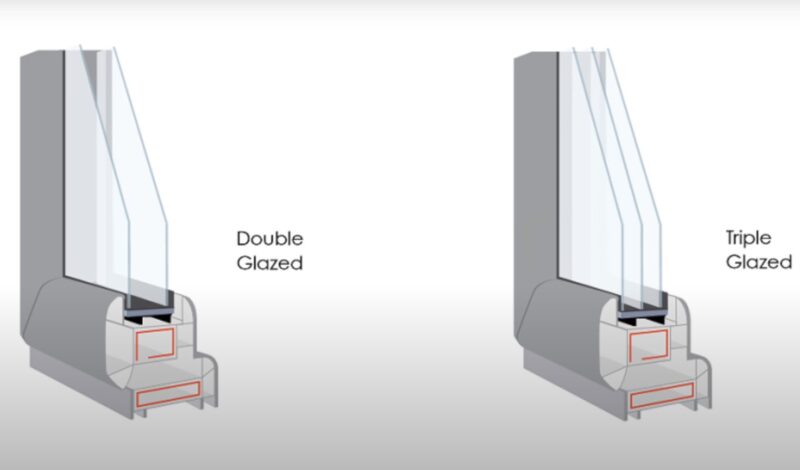In the hustle and bustle of modern life, finding peace has become a precious commodity. One of the most common culprits of noise pollution in our homes is our windows.
The Fundamentals

Unwanted noise can significantly disrupt one’s peace and tranquility. Fortunately, there are effective strategies to combat noise pollution, particularly when it comes to soundproofing windows.
1. Double Glazing
Double glazing stands as a highly efficient technique for soundproofing windows. This method incorporates two separate glass panes, separated by a gap.
The space between these panes plays a crucial role, serving as an additional barrier to impede the passage of sound waves. The effectiveness of double glazing in noise reduction is rooted in this dual-layer structure, which significantly disrupts the sound transmission compared to single-pane windows.
2. Sealing Air Gaps
Sound can infiltrate through even the tiniest of gaps, making it essential to ensure airtight sealing of windows. To combat this, employing acoustic caulk or weatherstripping around window frames can be highly effective.
These materials are designed to fill in any gaps, preventing the penetration of external noise. Proper sealing not only contributes to soundproofing but also enhances the overall thermal efficiency of the windows.
3. Soundproof Curtains and Blinds
In addition to structural modifications, the use of heavy, dense curtains or specially designed soundproof blinds can significantly aid in noise reduction. These materials are capable of absorbing sound waves, thereby diminishing the amount of noise that enters the living space.
Soundproof curtains and blinds offer a dual benefit: they contribute to the aesthetic appeal of the interior while serving as a functional element in reducing noise pollution. This solution is particularly beneficial for those seeking a less invasive and more decorative approach to soundproofing.
DIY Soundproofing Techniques
Soundproofing your home doesn’t have to be a complex or expensive task. Here are three DIY techniques that can significantly reduce noise transmission through windows:
1. Acoustic Caulk
One of the simplest and most effective DIY methods for soundproofing windows is the use of acoustic caulk. This specialized caulk is designed to fill in and seal off any gaps or cracks around the window frame.
By creating a tight seal, acoustic caulk acts as a barrier against noise, preventing sound waves from penetrating through these vulnerable points. It’s an affordable and straightforward solution that homeowners can easily apply themselves, enhancing the overall sound insulation of their windows.
2. Weatherstripping Tape
Weatherstripping tape is another accessible DIY option for reducing noise transmission through windows. This tape is specifically crafted to plug air holes and gaps that may exist around the window frames.
When applied correctly, weatherstripping tape provides an additional layer of insulation, not just for sound but also for thermal purposes. This dual function makes it an economical and efficient choice for enhancing the comfort and quietness of a living space.
3. Window Inserts
For those seeking a more robust solution, creating custom-made or DIY window inserts can be highly effective. These inserts are designed to fit snugly into the existing window frame, adding an extra layer of sound-dampening material.
The added mass and density of these inserts play a critical role in absorbing and reducing the transmission of external noise into the home. Window inserts can be made from various materials, including acrylic or glass, and can be tailored to fit the specific dimensions and aesthetics of your windows.
They offer a balance between functionality and minimal alteration to the existing window structure.
Advanced Soundproofing Solutions
For those dealing with high levels of external noise or seeking more sophisticated soundproofing solutions, advanced techniques can be the answer. These solutions offer enhanced noise reduction and are particularly useful in urban settings or noisy environments.
1. Laminated Glass
Laminated glass is a sophisticated solution for soundproofing windows, particularly effective in environments with high noise levels. This type of glass is constructed with two or more panes, separated by a layer of vinyl or a similar sound-dampening material.
The vinyl interlayer not only enhances the sound insulation properties of the glass but also adds to its safety and security features. Laminated glass windows are capable of significantly reducing the penetration of external noise, making them an ideal choice for urban homes, offices, or buildings located near busy areas.
2. Noise-Blocking Window Treatments
Another advanced approach involves the installation of noise-blocking window treatments. These treatments include specially designed curtains, blinds, or shutters that are engineered to absorb and diminish sound levels.
Unlike regular curtains or blinds, these noise-blocking alternatives are typically made from heavier, denser materials that are more effective in reducing the infiltration of sound. They are not only functional in mitigating noise pollution but also add an aesthetic touch to the interior decor, making them a dual-purpose solution.
3. Mass Loaded Vinyl (MLV)
Mass Loaded Vinyl (MLV) is a versatile and highly effective material for soundproofing windows. MLV is a dense, yet flexible, sheet that can be applied directly to windows or window frames to add mass and block out sound waves.
Its high mass-to-thickness ratio makes it particularly efficient in dampening noise, especially low-frequency sounds. MLV can be used in conjunction with other soundproofing methods, such as double glazing or weatherstripping, to enhance the overall sound insulation of a window system.
This solution is well-suited for those seeking to significantly upgrade their existing window soundproofing without complete window replacement.
Cost

To provide a clearer understanding of the cost implications of various soundproofing techniques, here’s a comparison table that outlines the approximate cost ranges and factors for each method.
| Soundproofing Solution | Approximate Cost Range | Cost Factors | Cost Range |
|---|---|---|---|
| Double Glazing | High ($200 – $1000+ per window) | Window size, type of glass, installation complexity | High |
| Sealing Air Gaps (Acoustic Caulk, Weatherstripping) | Low ($5 – $50) | Type and quantity of material, brand | Low |
| Soundproof Curtains and Blinds | Moderate ($50 – $300+ per window) | Material quality, size of the window, design complexity | Moderate |
| Acoustic Caulk | Very Low ($10 – $30 per tube) | Brand, type of caulk | Low |
| Weatherstripping Tape | Very Low ($5 – $20 per roll) | Material type, length of the roll | Low |
| Window Inserts | Moderate to High ($100 – $500+ per window) | Material used, custom sizing, installation difficulty | High |
| Laminated Glass | High ($300 – $1000+ per window) | Glass type, window size, installation charges | High |
| Noise-Blocking Window Treatments | Moderate ($100 – $500+ per window) | Fabric quality, size of the window, custom designs | Moderate |
| Mass Loaded Vinyl (MLV) | Moderate to High ($1 – $3 per square foot) | Amount needed, thickness of the vinyl, installation if needed | High |
Note: The prices are approximate and can vary based on location, specific product choices, and market conditions. This table should be used as a guideline rather than an exact pricing chart.
For precise cost estimations, it’s advisable to consult with local suppliers or professionals.
FAQ
Do soundproof curtains work?
Absolutely. Soundproof curtains are made of heavy, dense materials that absorb sound waves, effectively reducing the noise that enters your space. They are a practical solution for those seeking a non-invasive and decorative approach.
Can I soundproof my existing windows without replacing them?
Yes, you can soundproof existing windows using methods like installing window inserts, applying acoustic caulk, or using weatherstripping tape. These techniques enhance the sound insulation of your current windows without the need for complete replacement.
Is it possible to have soundproof windows in a rented apartment?
Yes, there are temporary soundproofing solutions suitable for renters, such as using removable window inserts, applying temporary weatherstripping, or hanging soundproof curtains or blinds.
How does double glazing compare to laminated glass in terms of soundproofing?
Double glazing and laminated glass both offer effective sound insulation, but laminated glass has the added benefit of a vinyl interlayer, providing superior noise reduction, especially in high-noise areas.
Can Mass Loaded Vinyl (MLV) be used on all types of windows?
Yes, MLV is versatile and can be applied to various window types. Its flexible nature allows it to be fitted onto different shapes and sizes, effectively blocking sound waves.
Does soundproofing windows also improve their thermal efficiency?
Many soundproofing methods, like double glazing and weatherstripping, also enhance the thermal efficiency of windows, providing both sound insulation and energy-saving benefits.
Final Words
Soundproofing your windows enhances the quality of your space, offering comfort and tranquility. From simple DIY methods like acoustic caulk to advanced solutions like laminated glass, each technique significantly contributes to a peaceful environment.
Getting to know sound transmission and the effectiveness of soundproofing materials enables tailored, informed decisions. This investment not only blocks noise but also transforms your space into a serene, focused, and enjoyable environment.
